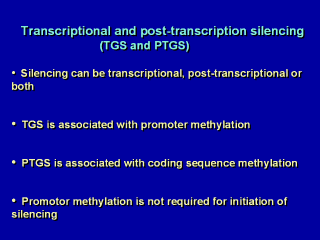| front |1 |2 |3 |4 |5 |6 |7 |8 |9 |10 |11 |12 |13 |14 |15 |16 |17 |18 |19 |20 |21 |22 |23 |24 |25 |26 |27 |28 |29 |30 |31 |32 |33 |review |
 |
Now as I noted earlier, some genes silenced by
the introduction of transgenes are re-expressed when segregated from the
transgene and in other cases they are not. 1. Transgenes that are readily reactivated upon segregation are generally not methylated and are inactivated post-transcriptionally. This is called post-transcriptional gene silencing or PTGS. 2. Transcription from such genes, as detected by run-on transcription assays, is not inhibited. That is, the phenotypically silenced genes are transcribed, often at high levels, but there is little steady-state RNA accumulation. This means that the silencing occurs by a post-transcriptional mechanism that either destabilizes the RNA or results in its premature truncation. 3. Promoter methylation is generally detected when transgenes are transcriptionally silenced, while post-transcriptionally silenced genes are often methylated in the coding region. 4. There is evidence from Herve Vaucheretís lab that promoter methylation is required for the mainenance of transcriptional gene silencing, but not its initiation. Having made all these generalizations, I have to remind you that all generalizations, including the present ones, are suspect. Going back a moment to maize and paramutation, what I described for the R locus clearly falls into the category of TGS. But paramutation is likely to involve more than one epigenetic mechanism. Paramutation has also been studied at the maize B locus and found to have quite different properties. In this case, the paramutagenic allele exerts its influence in the F1 heterozygote and methylation has never been detected. Whatís common to both is that the interaction between alleles results in a heritable change in gene expression of the paramutable allele. |